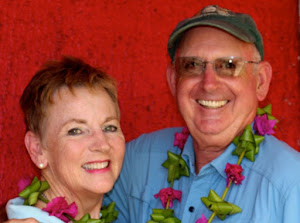Nara, Ancient Capital of Japan,
Another grey and rainy day greeted us this morning. The temperature is cooler. It would be tempting to stay warm and cozy with a book and a cup of tea. Hopefully, that is what one of our ailing members will take advantage of today, and we will be back at full strength tomorrow. In the mean time, the rest of us are on the bus heading from Kyoto to Nara. The trip should take about an hour. Nara was the capital before the Shogunates from 710-794 CE.during the reign of Emperor Shomu.
When we arrived at the Temple we were met by hundreds of deer that are fed rice cakes by tourists and worshippers.
The deer hang out by the rice cake kiosk, and aggressively approach visitors like the monkeys do in south east Asia.
The deer hang out by the rice cake kiosk, and aggressively approach visitors like the monkeys do in south east Asia.
Some of the male deer try to establish their territory and butt heads despite the fact that their horns have been nipped off. I took a photo of this one male,
and he walked around behind me and put his head down like he was going to butt, but I moved my butt quickly out of the way.
The temple was built during the reign of Emperor Shomu (r 724-749) and was officially positioned as one of many state-established provincial temples. Todaiji Temple represents “Buddha that shines throughout the world like a sun.” and is magnificently built with grandeur to match the significance of the Buddha.
 |
| Note the size of people in the massive doorways. |
 |
| Add caption |
 |
| Russ looks very small compared to these doors. |
 |
| Note the size of Buddah's Nostrils - Largest bronzed Buddah in the world. |
The Great Buddha hall was burned in the fires of war in 1180 and 1567.
The currently building is a third generation structure, which was built in the Edo period. The width of the current building is approximately 33% smaller than that of
the original structure, but it still ranks as the largest wooden structure in the world.
Inside the temple, one can write hopes and prayers on a wooden ornament. Friendship Force Sacramento send these wishes your way.
 |
| Part of the fun of this temple is to crawl through a hole in a pillar the size of Buddha's Nostril. |
The currently building is a third generation structure, which was built in the Edo period. The width of the current building is approximately 33% smaller than that of
the original structure, but it still ranks as the largest wooden structure in the world.
Inside the temple, one can write hopes and prayers on a wooden ornament. Friendship Force Sacramento send these wishes your way.
We liked this one, too.
The trails and steps to the shrine are lined with stone pillared lanterns. Worshipper-donners buy candles for 3,000 yen and place their candle inside the stone lantern and cover the holes with prayer paper. They are lit twice a year, once in early February, and one in mid August. The shrine was built in 768 CE and is Nara's most celebrated. It is UNESCO World Heritage Site as it has over 3,000 stone lanterns plus metal lanterns.
Nara Park and Kasuga Taisha Shrine
 |
| Zen dry garden |
We returned to Kyoto and our hotel by 1:00 pm, took an hour of rest, and was out the door to do some more exploring, accompanied by when of our fellow Friendship Force Member, Andy N.
Yodobashi Camera Store was our first stop where we mostly look-see shopped. The Buddhist monks were checking out the head shaving equipment. We were on the hunt for a rubber tip for my umbrella, luggage strap, and Andy was searching for a light-weight inexpensive duffle and some chopsticks.




























































































